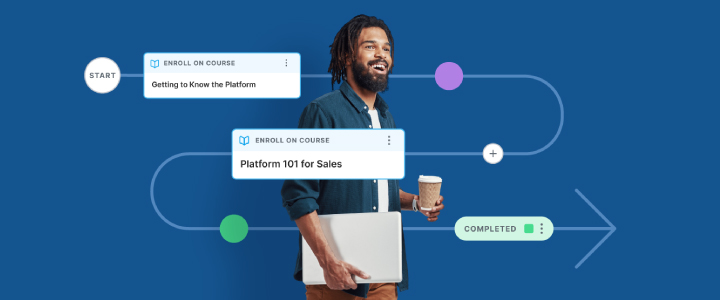
4 min reading time
What are the 6 Blended Learning Models?
Blended learning, also known as “hybrid learning,” combines the benefits of online learning with the proven effectiveness of classroom learning. Just as an increasing number of employers have shifted their workforce to a hybrid structure, blended learning models offer flexibility without sacrificing technological innovation.
In this post, we’ll detail the six blended learning models. Specifically, we’ll highlight the similarities, differences, and benefits that each model offers.
1. Face-to-face driver model
What is the face-to-face driver learning model?
This model offers what is the most similar to a traditional classroom experience. Learners join a live webinar or meeting (like Zoom or Google Meet), receive live instruction, and at the conclusion of each session are given homework or assignments to be completed before the next session.
Benefits and drawbacks of the face-to-face driver learning model
The face-to-face driver learning model obviously requires more instructor time and energy than some of the other models, but it can be extremely effective for learners who need more extrinsic motivation, or are earlier in their specific roles/career. Because the model mirrors a traditional classroom in many ways, it can also be a good option for those who are less technically adept.
2. Flipped model
What is the flipped learning model?
The flipped model is similar to the face-to-face driver model discussed above, except that learners are provided with learning materials and resources (often distributed via an LMS) before each virtual classroom experience.
Benefits and drawbacks of the flipped learning model
The flipped model is another option for a learning cohort that would benefit from active, live classroom instruction, and thus it also requires more instructor time and energy. What proponents of the flipped model appreciate, however, is that it has the potential to increase the level of preparedness and interaction among learners.
3. Enriched virtual model
What is the enriched virtual learning model?
This model allows learners to set the pace of their learning, and complete most of their coursework virtually. Learners are given the opportunity to attend webinars with the instructor at their convenience, but ultimately it’s the learner that determines how much of their learning includes live interaction with the instructor.
Benefits and drawbacks of the enriched virtual learning model
The enriched virtual learning model can be great for self-motivated learners that appreciate autonomous learning. In having the option to interface with the instructor, they enjoy the balance between feeling supported, without feeling hindered by mandatory live instruction at a set date and time.
4. Flex model
What is the flex learning model?
The flex learning model offers learners the opportunity to direct their learning according to what works best for them. They are able to jump between synchronous and asynchronous instruction, individual assignments, and even group learning. Instructors are available to answer questions and provide feedback, but it’s up to each participant how and when they utilize instructor resources.
Benefits and drawbacks of the flex learning model
The flex learning model is great for self-motivated learners who understand (or are willing to experiment with) how different instructional methods impact their learning. One downside to this, however, is that instructors must be “on call” (although much of this time is likely not spent engaging in active instruction). One other potential downside is that unmotivated learners may simply stick with the method of instruction that is most familiar to them, or seems the easiest or fastest, rather than embracing the personalization this learning model offers.
5. Rotation model
What is the rotation learning model?
The rotation learning model is something of a grab bag. Learners are divided into smaller groups, and then they rotate between individual instruction (typically via a pre-recorded webinar), live group instruction (via Zoom or another webinar tool), and self-guided assignments. Where the flex learning model allows learners to ultimately decide which methods of learning are most effective, the rotation learning model offers a similar level of flexibility, but determined by the instructor.
Benefits and drawbacks of the rotation learning model
The rotation model can be highly effective across learners that prefer different learning experiences. Because they get a combination of self-guided and instructor-led learning, participants will be able to make the most of their preferred method of instruction. Where the rotation model can be demanding, however, is in the level of organization that it requires. Because of this reason, many instructors rely heavily on a learning management system in order to provide a learning experience that’s applicable and easy to understand.
6. Online driver model
What is the online driver learning model?
The online driver learning model offers the maximum amount of learner autonomy. Participants make their way through the learning models at their own pace, and according to their own drive and motivation. While learners are still given the opportunity to communicate with trainers as needed, such communication is not a requirement of completing the training.
Benefits and drawbacks of the online driver learning model
Just as the enriched virtual learning model can be effective for experienced, self-motivated learners, the online driver learning model takes this level of autonomy and turns it to the maximum level. Because of this, the online driver learning model requires the least amount of instructor time and energy. Unmotivated or tentative learners, however, might find themselves confused or simply going through the motions without achieving a deep understanding of the course material.
Which learning model should you choose?
Because every organization has different needs and resources, it’s impossible to conclude that one blending learning model is outright preferable to another. It’s up to L&D teams to draw upon their experience, LMS metrics, and learner feedback to choose a learning model that best fulfills the purpose of the organization’s training goals without overburdening trainers unnecessarily.



